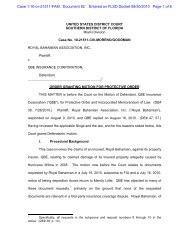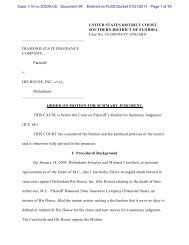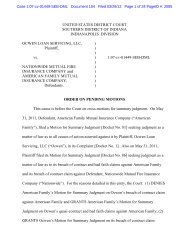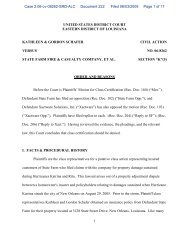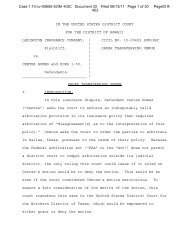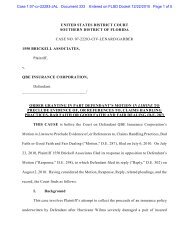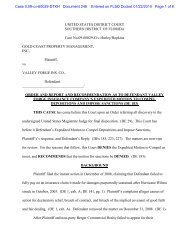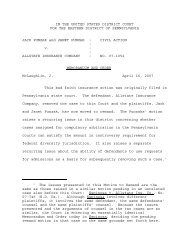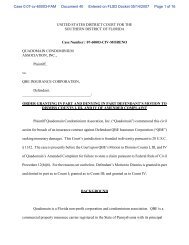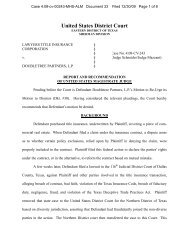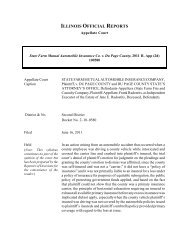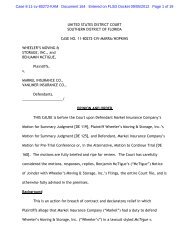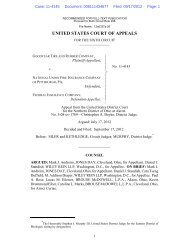v. SCOTTSDALE INSURANCE CO - Insurance Claims And Issues
v. SCOTTSDALE INSURANCE CO - Insurance Claims And Issues
v. SCOTTSDALE INSURANCE CO - Insurance Claims And Issues
Create successful ePaper yourself
Turn your PDF publications into a flip-book with our unique Google optimized e-Paper software.
IN THE SUPREME <strong>CO</strong>URT OF MISSISSIPPI<br />
NO. 2008-CA-01353-SCT<br />
ARCHITEX ASSOCIATION, INC. (“ARCHITEX”)<br />
v.<br />
<strong>S<strong>CO</strong>TTSDALE</strong> <strong>INSURANCE</strong> <strong>CO</strong>MPANY<br />
(“<strong>S<strong>CO</strong>TTSDALE</strong>”)<br />
DATE OF JUDGMENT: 05/14/2008<br />
TRIAL JUDGE:<br />
HON. KENT McDANIEL<br />
<strong>CO</strong>URT FROM WHICH APPEALED: RANKIN <strong>CO</strong>UNTY CIRCUIT <strong>CO</strong>URT<br />
ATTORNEYS FOR APPELLANT: DORSEY R. CARSON, JR.<br />
CHERI TURNAGE GATLIN<br />
JOHN MARTIN LASSITER<br />
BRADLEY BARRON VANCE<br />
ERIC FOSTER HATTEN<br />
ATTORNEYS FOR APPELLEE: JAMES W. SHELSON<br />
JAMES W. CRAIG<br />
JUSTIN L. MATHENY<br />
NATURE OF THE CASE:<br />
CIVIL - <strong>INSURANCE</strong><br />
DISPOSITION: REVERSED AND REMANDED - 02/11/2010<br />
MOTION FOR REHEARING FILED:<br />
MANDATE ISSUED:
BEFORE WALLER, C.J., RANDOLPH AND CHANDLER, JJ.<br />
RANDOLPH, JUSTICE, FOR THE <strong>CO</strong>URT:<br />
1<br />
1. The parties and amici assert the matter before this Court is a case of first impression.<br />
This Court is called upon to determine whether Architex Association, Inc.’s (“Architex”)<br />
intentional hiring or utilization of subcontractors to perform work on one of its projects<br />
negates coverage included in the Commercial General Liability (“CGL”) coverage part of<br />
three separate “Commercial Lines” policies issued by Scottsdale <strong>Insurance</strong> Company<br />
(“Scottsdale”) to Architex. Scottsdale prevailed on its “Motion for Summary Judgment”<br />
after the Circuit Court of Rankin County, Mississippi, held that no coverage exists. Architex,<br />
a general contractor, appeals that ruling.<br />
FACTS<br />
2. On April 14, 2000, Architex entered into a contract with Vikram Parshotam and CIS<br />
Pearl, Inc. (“CIS”) to construct a Country Inn and Suites hotel (“Inn”). On July 25, 2000, a<br />
performance bond with The Hanover <strong>Insurance</strong> Company (“Hanover”), as surety, and<br />
Architex, as principal, was issued for $1.89 million pertaining to work to be performed on<br />
the Inn. Architex used multiple subcontractors to build the Inn.<br />
1<br />
Amicus briefs were filed in support of Architex’s position by the Mississippi<br />
Department of Finance and Administration, Bureau of Building, Grounds and Real Property<br />
Management; Mississippi <strong>Insurance</strong> Department; Mississippi Department of Transportation;<br />
and the State of Mississippi, ex. rel Attorney General Jim Hood; as well as the Associated<br />
General Contractors of America and the Associated General Contractors of Mississippi<br />
(“Contractors”). Joinder in the briefs of Architex and/or the Contractors were filed by the<br />
Mississippi Asphalt Pavement Association, Inc.; the Associated Builders and Contractors,<br />
Inc., the Mississippi Associated Builders and Contractors, Inc.; the American Subcontractors<br />
Association; and the American Subcontractors Association of Mississippi.<br />
2
3. On June 21, 2002, a “Statutory Notice of Construction Lien” was filed by Architex<br />
“for construction balance due on Country Inn & Suites . . . of $256,075.” Architex had yet<br />
to file suit. On July 31, 2002, CIS filed suit against Architex and Hanover. The suit alleged<br />
that Architex had breached its contract; “was negligent in the construction of the [Inn] and<br />
such negligence is the sole proximate cause or a proximate contributing cause of injuries to<br />
[CIS]”; and that the construction lien claimed by Architex constituted slander of title.<br />
Regarding breach of contract, CIS’s complaint provided that Architex:<br />
abandon[ed] the [Inn], refus[ed] to complete the work, perform[ed] work<br />
which was contrary to the contract plans and specifications and contrary to<br />
applicable codes and building standards, and . . . fail[ed] to correct or remedy<br />
defective work. Architex has also failed to reimburse [CIS] for monies<br />
expended for the [Inn] which were to be paid by Architex.<br />
As to Hanover, CIS asserted a “performance bond claim,” stating that Hanover “has not<br />
corrected Architex’s non-conforming, incomplete and defective work on the [Inn].”<br />
Architex considered the suit as a mere fee dispute, and did not notify Scottsdale of the suit<br />
or otherwise file a claim.<br />
4. It was not until September 2004 that counsel for CIS communicated to Architex an<br />
allegation that testing had revealed serious rebar deficiencies in the foundation of the Inn,<br />
inter alia. On October 5, 2004, Architex first notified Scottsdale of that claim. The notice<br />
of claim alleged that the “date of occurrence” was September 30, 2004, and described the<br />
purported “occurrence,” as follows:<br />
[CIS] filed accusations of faulty work against [Architex] claiming that no rebar<br />
was placed in foundation and building is total loss. [Architex] denies this<br />
allegation and building is sound. . . . This accusation was just made by [CIS].<br />
[Architex] has been involved in legal action against [CIS] for failure to pay<br />
3
monies owed on this building. . . . Please contact [Architex’s] attorney to<br />
coordinate defense. [Inn] was built during policy term.<br />
Victor Hamby, the chief financial officer of Architex, testified that notice of the rebar claim<br />
“trigger[ed] an [‘]occurrence[’] under the policy.”<br />
5. On October 8, 2004, Scottsdale sent a letter to Hamby confirming receipt of the notice<br />
of claim. The letter added that Scottsdale had yet to receive a copy of CIS’s complaint, noted<br />
policy exclusions and definitions, and concluded that Scottsdale “is reserving the right to<br />
assert all defenses to coverage under the policy. . . . [Scottsdale] is not waiving any rights<br />
nor admitting any obligation under the policy.” On April 21, 2005, at the latest, Scottsdale<br />
received a copy of the CIS complaint, which had been filed on July 31, 2002.<br />
6. On June 29, 2006, Architex filed a “Third Party Complaint” against Scottsdale for<br />
2<br />
failure “to provide Architex with defense and indemnity.” On July 25, 2006, Scottdale filed<br />
its answer and defenses seeking dismissal of Architex’s “Third Party Complaint” with<br />
3<br />
prejudice. On September 6, 2006, Scottsdale formally denied Architex’s demand for<br />
defense and indemnity, stating, inter alia, that “there has not been any ‘occurrence’ which<br />
would trigger” coverage.<br />
2<br />
Architex filed three subsequent amended third party complaints. Notably, the “First<br />
Amended Third Party Complaint” added certain subcontractors as third-party defendants and<br />
sought a declaratory judgment that Scottsdale had a duty to defend and indemnify Architex<br />
under the policy. The “Third Amended Third Party Complaint” alleged “five additional<br />
counts against [Scottsdale], including: breach of contract, breach of duty to defend, bad faith<br />
refusal to indemnify, bad faith failure to investigate, and breach of duty of good faith and fair<br />
dealing.”<br />
3<br />
Scottsdale answered the amended third-party complaints in the same manner.<br />
4
7. Before the controversy erupted between CIS and Architex, Scottsdale had issued three<br />
consecutive one-year “Commercial Lines” policies to Architex. Each policy included a CGL<br />
part. The policies contained substantially similar language and collectively covered the<br />
period from June 29, 1999, to June 29, 2002. An “Extension of Supplemental Declarations”<br />
of the CGL part reveals that in exchange for CGL coverage, Architex paid premiums of<br />
4<br />
$6,330 in 1999 and 2000, and $7,250 in 2001. Of these premiums, $3,705 in 1999 and<br />
2000, and $4,233 in 2001, were for “Class Description: Contractors - Subcont Work - In<br />
5<br />
Conn W/ Constr - Bldgs.” The policies, as amended, provided, in pertinent part, that:<br />
SECTION I - <strong>CO</strong>VERAGES<br />
<strong>CO</strong>VERAGE A [-] BODILY INJURY AND PROPERTY DAMAGE LIABILITY<br />
1. INSURING AGREEMENT<br />
a. We will pay those sums that the insured becomes legally obligated to pay<br />
as damages because of “bodily injury” or “property damage” to which this<br />
insurance applies. We will have the right and duty to defend the insured<br />
4<br />
The policies also provided liability coverage for non-owned autos, in exchange for<br />
separate premiums.<br />
5<br />
The policies also included “Contractors Special Conditions,” which stated that:<br />
[y]ou will obtain certificates of insurance from all independent contractors<br />
providing evidence of:<br />
1. Limits of [i]nsurance equal to or greater than the limits<br />
provided by this policy; and<br />
2. Coverage equal to or greater than the coverages provided by<br />
this policy.<br />
Failure to comply with this condition does not alter the coverage provided by<br />
this policy. However, should you fail to comply, a premium charge will be<br />
made.<br />
5
against any “suit” seeking those damages. However, we will have no duty to<br />
defend the insured against any “suit” seeking damages for “bodily injury” or<br />
“property damage” to which this insurance does not apply. We may, at our<br />
discretion, investigate any “occurrence” and settle any claim or “suit” that may<br />
result. But:<br />
. . .<br />
(1) The amount we will pay for damages is limited as described<br />
in Section III - Limits Of <strong>Insurance</strong> . . . .<br />
6<br />
b. This insurance applies to “bodily injury” and “property damage”[ ] only<br />
if:<br />
. . .<br />
(1) The “bodily injury” or “property damage” is caused by an<br />
7<br />
“occurrence”[ ] that takes place in the “coverage territory”; and<br />
(2) The “bodily injury” or “property damage” occurs during the<br />
policy period . . . .<br />
2. EXCLUSIONS<br />
This insurance does not apply to[:]<br />
a. Expected or Intended Injury<br />
“Bodily injury” or “property damage” expected or intended from the<br />
standpoint of the insured.<br />
6<br />
The policy defines “property damage” as:<br />
a. Physical injury to tangible property, including all resulting loss of use of<br />
that property. All such loss of use shall be deemed to occur at the time of the<br />
physical injury that caused it; or<br />
b. Loss of use of tangible property that is not physically injured. All such loss<br />
of use shall be deemed to occur at the time of the “occurrence” that caused it.<br />
7<br />
The policy defines “occurrence” as “an accident, including continuous or repeated<br />
exposure to substantially the same general harmful conditions.” (Emphasis added.)<br />
6
. . .<br />
j. Damage to Property<br />
“Property damage” to:<br />
. . .<br />
. . .<br />
(5) That particular part of real property on which you or any<br />
contractors or subcontractors working directly or indirectly on<br />
your behalf are performing operations, if the “property damage”<br />
arises out of those operations; or<br />
(6) That particular part of any property that must be restored,<br />
8<br />
repaired or replaced because “your work”[ ] was incorrectly<br />
performed on it.<br />
Paragraph (6) of this exclusion does not apply to “property damage” included<br />
in the “products-completed operations hazard.”[ 9 ]<br />
8<br />
The policy defines “your work” as:<br />
a. Work or operations performed by you or on your behalf; and<br />
b. Materials, parts or equipment furnished in connection with such work or<br />
operations.<br />
“Your work” includes:<br />
a. Warranties or representations made at any time with respect to the fitness,<br />
quality, durability, performance or use of “your work” . . . .<br />
it:<br />
9<br />
Regarding the “products-completed operations hazard,” the policy states, in part, that<br />
a. Includes all “bodily injury” and “property damage” occurring away from<br />
premises you own or rent and arising out of “your product” or “your work”<br />
except:<br />
. . .<br />
7
. . .<br />
l. Damage to Your Work<br />
“Property damage” to “your work” arising out of it or any part of it and<br />
included in the “products-completed operations hazard.”<br />
This exclusion does not apply if the damaged work or the work out of which<br />
the damage arises was performed on your behalf by a subcontractor.<br />
m. Damage to Impaired Property Or Property Not Physically Injured<br />
“Property damage” to “impaired property” or property that has not been<br />
physically injured, arising out of:<br />
(1) A defect, deficiency, inadequacy or dangerous condition in<br />
“your product” or “your work”; or<br />
(2) A delay or failure by you or anyone acting on your behalf to<br />
perform a contract or agreement in accordance with its terms.<br />
. . .<br />
(Emphasis added.)<br />
(2) Work that has not yet been completed or abandoned.<br />
However, “your work” will be deemed completed at the earliest<br />
of the following times:<br />
(a) When all of the work called for in your<br />
contract has been completed.<br />
(c) When that part of the work done at a job site<br />
has been put to its intended use by any person or<br />
organization other than another contractor or<br />
subcontractor working on the same project.<br />
Work that may need service, maintenance, correction, repair or<br />
replacement, but which is otherwise complete, will be treated as<br />
completed.<br />
8
This exclusion does not apply to the loss of use of other property arising out<br />
of sudden and accidental physical injury to “your product” or “your work”<br />
after it has been put to its intended use.<br />
n. Recall Of Products, Work Or Impaired Property<br />
Damages claimed for any loss, cost or expense incurred by you or others for<br />
the loss of use, withdrawal, recall, inspection, repair, replacement, adjustment,<br />
removal or disposal of:<br />
(1) “Your product”;<br />
(2) “Your work”; or<br />
(3) “Impaired property”;<br />
if such product, work, or property is withdrawn or recalled from the market or<br />
from use by any person or organization because of a known or suspected<br />
defect, deficiency, inadequacy or dangerous condition in it.<br />
(Emphasis added.)<br />
8. On March 28, 2008, Architex filed a “Motion for Summary Judgment,” asserting that:<br />
[CIS] claims property damage resulting from acts which were not intended by<br />
the insured, Architex. Therefore, there is an occurrence and Scottsdale’s<br />
policy is triggered. At a minimum, some or all of [CIS’s] allegations are<br />
arguably covered by the policy. Scottsdale therefore owes Architex a duty to<br />
defend as a matter of law.<br />
Scottsdale responded with its own “Motion for Summary Judgment.” Regarding non-badfaith<br />
claims, Scottsdale maintained that it “does not have a duty to defend because . . . [t]he<br />
allegations contained in [CIS’s] complaint, as well as those which have claimed to have been<br />
asserted outside of the complaint, do not constitute an ‘occurrence’ under the policy or are<br />
otherwise excluded from coverage.” (Emphasis added.)<br />
9
10<br />
9. Following a hearing, the circuit court issued a “Bench Opinion Regarding Cross<br />
Motions for Summary Judgment.” The circuit court held that “the type of damage, coverage<br />
for that damage, whether it was caused by a subcontractor, and all similar issues are moot on<br />
account of the meaning of other language in the policy.” Specifically:<br />
this [c]ourt is convinced that this particular case is quite simple and that the<br />
controlling law on this policy language revolves around the word<br />
“occurrence.” The controlling and/or strongly persuasive case law has defined<br />
plainly how that word is to be interpreted and applied. While it may be time<br />
for the [c]ourts of this state to expand that language and law so as to bring<br />
construction defects under the indemnity and defense obligations included in<br />
CGL policy language, this trial court is not at liberty to do so in the face of<br />
binding precedent.<br />
(Emphasis added.) According to the circuit court, the:<br />
definition of “occurrence” being parsed by the [Mississippi] Supreme Court<br />
in [United States Fidelity & Guaranty Company v. Omnibank, 812 So. 2d<br />
196 (Miss. 2002)] is verbatim identical to the language in the policy at issue<br />
here. In fact, all of the CGL Coverage Form language quoted in Omnibank<br />
and virtually every other case studied appears to be a verbatim recitation of the<br />
language at issue here.<br />
(Emphasis in original.)<br />
10. In the non-construction-defect context of Omnibank, this Court found “that coverage<br />
does not apply to ‘bodily injury’ or ‘property damage’ that is expected or intended from the<br />
standpoint of the insured.” Omnibank, 812 So. 2d at 199-200. In determining whether any<br />
“occurrence” exists, “[t]he only relevant consideration is whether, according to the<br />
declaration, the chain of events leading to the injuries complained of were set in motion and<br />
followed a course consciously devised and controlled by [the insured] without the<br />
10<br />
Rankin County Court Judge Kent McDaniel was appointed as Special Judge in the<br />
case sub judice by order of the circuit court.<br />
10
unexpected intervention of any third person or extrinsic force.” Id. at 200 (quoting Allstate<br />
Ins. Co. v. Moulton, 464 So. 2d 507, 509 (Miss. 1985)) (emphasis added).<br />
11. The circuit court’s reliance on Omnibank’s definition of “occurrence,” and the Fifth<br />
Circuit’s “Erie-guess” application in ACS Construction Company v. CGU, 332 F.3d 885,<br />
888-892 (5th Cir. 2003), concluded that:<br />
whatever work was improper or defective or was not completed, as alleged in<br />
the original complaint and via ensuing discovery, was nevertheless the result<br />
of intended action by the insured, Architex. Architex had a contract to build<br />
[the Inn]. It intentionally subcontracted the various portions of the work to<br />
others who entered contractual obligations to Architex. Architex undoubtedly<br />
did not intend for any of those subcontractors to do defective or improper<br />
work. However, the hiring of those subcontractors was not an “accident,<br />
including continuous or repeated exposure to substantially the same general<br />
harmful conditions” as the definition of “occurrence” sets out plainly in the<br />
insurance policy. Additionally, the hiring of the subs, was a “course<br />
consciously devised and controlled by [the insured]” which undeniably set in<br />
motion the “chain of events leading to the injuries complained of.”<br />
The circuit court ruled that “as coverage was never triggered, the [c]ourt must necessarily<br />
find that the duty to defend was likewise never triggered.” In granting summary judgment<br />
in favor of Scottsdale, the circuit court “resolve[d] against Architex any claim that it has or<br />
had against Scottsdale on account of the CGL policy at issue whether arising as a claim under<br />
the policy or a claim for bad faith in any way related to Scottsdale’s declination to indemnify<br />
and/or defend under the policy.”<br />
12. On May 14, 2008, the circuit court entered its “Final Judgment Dismissing Third<br />
Amended Third Party Complaint.” The final judgment specifically stated that “since there<br />
is no coverage, and correspondingly no duty to defend, as a matter of law Scottsdale cannot<br />
be held liable for its alleged failure to act in good faith and fair dealing, failure to investigate,<br />
11
failure to abide by its own policies and procedures, and failure to abide by nationallyrecognized<br />
industry standards.” On June 12, 2008, Architex filed notice of appeal.<br />
ISSUE<br />
13. This Court will consider only the limited and narrow issue of: 11<br />
Whether the circuit court erred in concluding, as a matter of law, that the<br />
intentional act of hiring subcontractors by the insured general contractor<br />
precludes the possibility of coverage.<br />
BACKGROUND<br />
14. Scottsdale’s “Commercial General Liability Coverage Form,” which contains the<br />
policy language quoted in 7 supra, provides at the bottom of each page “Copyright,<br />
<strong>Insurance</strong> Services Office, Inc. 1997.” “The vast majority of general liability policies sold<br />
in this country utilize language drafted by the <strong>Insurance</strong> Services Office . . . .” David<br />
Dekker, Douglas Green, Stephen Palley, The Expansion of <strong>Insurance</strong> Coverage for Defective<br />
Construction, 28 Construction Lawyer 19, 19-20 (Fall 2008). These policies:<br />
begin with a broad grant of coverage, which is then limited in scope by<br />
exclusions. Exceptions to exclusions narrow the scope of the exclusion and,<br />
as a consequence, add back coverage. However, it is the initial broad grant<br />
of coverage, not the exception to the exclusion, that ultimately creates (or does<br />
not create) the coverage sought.<br />
11<br />
Without filing a cross-appeal, Scottsdale raised the following issue in its Appellee’s<br />
Brief, “[d]oes an insured violate the notice requirements of its policy by failing to notify its<br />
insurer of the existence of a lawsuit for more than two years while defending the suit on its<br />
own and tactically positioning its defense to the insurer’s prejudice?” The circuit court<br />
expressly avoided addressing this issue in granting summary judgment to Scottsdale, stating<br />
“[t]his [c]ourt has not addressed a number of issues and bases urged upon the [c]ourt, e.g.<br />
whether notice of claim was timely made.” As such, and without passing judgment on the<br />
merits of the issue, this Court concludes that the issue is not properly before this Court at this<br />
time.<br />
12
Id. at 20 (emphasis added). See also Lamar Homes, Inc. v. Mid-Continent Cas. Co., 242<br />
S.W.3d 1, 10 (Tex. 2007) (quoting Weedo v. Stone-E-Brick, Inc., 81 N.J. 233, 405 A.2d 788,<br />
790 (1979)) (“[t]he CGL’s insuring agreement grants the insured broad coverage for property<br />
damage and bodily injury liability, which is then narrowed by exclusions that ‘restrict and<br />
shape the coverage otherwise afforded’”).<br />
15. Given the nature of these policies, the subject “coverage litigation often boils down<br />
to a dispute first over the meaning of the word ‘accident’ within the definition of<br />
‘occurrence’ and then the scope and application of the ‘your work’ exclusion.” Dekker, et<br />
al., The Expansion of <strong>Insurance</strong> Coverage for Defective Construction, 28 Construction<br />
Lawyer at 20. In the absence of an “occurrence,” there is no coverage. See U.S. Fire Ins.<br />
Co. v. J.S.U.B., Inc., 979 So. 2d 871, 880 (Fla. 2007) (“the subcontractor’s exception to the<br />
general exclusion for a contractor’s defective work becomes important only if there is<br />
coverage under the initial insuring provision”).<br />
16. There is a clear jurisdictional split regarding whether defective subcontractor<br />
construction constitutes an “occurrence” under a CGL policy. See Gen. Sec. Indem. Co. of<br />
Ariz. v. Mountain States Mut. Cas. Co., 205 P.3d 529, 535 (Colo. Ct. App. 2009) (examples<br />
noted); J.S.U.B., 979 So. 2d at 885-86 (examples noted); Lamar Homes, 242 S.W.3d at 5-6<br />
n.2 & 3 (examples noted); Dekker, et al., The Expansion of <strong>Insurance</strong> Coverage for Defective<br />
Construction, 28 Construction Lawyer at 23 nn.25 & 26 (examples noted). The Supreme<br />
Court of Kansas has explained the opposing views, as follows:<br />
one line of cases has held that faulty or improper construction does not<br />
constitute an accident; rather, the damage is the natural and ordinary<br />
13
12<br />
consequence of the insured’s act.[ ] The other line of cases has held that<br />
improper or faulty construction does constitute an accident as long as the<br />
resulting damage is an event that occurs without the insured’s expectation or<br />
13<br />
foresight.[ ]<br />
Lee Builders, Inc. v. Farm Bureau Mut. Ins. Co., 281 Kan. 844, 137 P.3d 486, 491 (2006).<br />
12<br />
A policy justification adopting this view was employed in the circuit court’s<br />
reasoning that general contractors should bear the responsibility for properly selecting and<br />
supervising subcontractors; and that to hold otherwise would both transform the policy into<br />
a performance bond and risk creating moral hazard on the part of general contractors,<br />
thereby providing an unjustified windfall to said general contractors.<br />
13<br />
The espoused policy justifications for this view include that it comports with the<br />
policy language and that “if the insurer decides that this is a risk it does not want to insure,<br />
it can clearly amend the policy to exclude coverage, as can be done simply by either<br />
eliminating the subcontractor exception or adding a breach of contract exclusion[,]”<br />
J.S.U.B., 979 So. 2d at 891; that “the fact that the general contractor receives coverage will<br />
not relieve the subcontractor of ultimate liability . . . [as] an insurer will have subrogation<br />
rights against the subcontractor who performed the defective work[,]” O’Shaughnessy v.<br />
Smuckler Corp., 543 N.W.2d 99, 102 (Minn. Ct. App. 1996), abrogated on other grounds<br />
by Gordon v. Microsoft Corp., 645 N.W.2d 393 (Minn. 2002); and that an insurance policy<br />
is distinguishable from a performance bond insofar as “an insurance policy spreads the<br />
contractor’s risk while a bond guarantees its performance[, and] . . . [u]nlike insurance, the<br />
performance bond offers no indemnity for the contractor; it protects only the owner.” Lamar<br />
Homes, 242 S.W.3d at 10 n.7.<br />
14
ANALYSIS<br />
17. We find the appropriate analysis should not be driven by policy justifications, but<br />
rather should be confined to the policy language. The policy either affords coverage or not,<br />
based upon application of the policy language to the facts presented. See Corban v. United<br />
Servs. Auto. Ass’n, 20 So. 3d 601, 609 (Miss. 2009). The second consideration is that<br />
neither faulty or improper construction, nor defective workmanship (or gaining knowledge<br />
of same) constitutes an “occurrence,” as defined in the policy. The aforementioned are<br />
typically the result of either accidental or intentional acts. These CGL policies are designed<br />
to provide liability protection for the general contractor and their subcontractors for<br />
accidental, inadvertent acts which breach accepted duties and proximately cause damage to<br />
a person or property.<br />
18. This Court has stated that:<br />
[t]he circuit court’s grant [or denial] of a motion for summary judgment is<br />
reviewed by this Court de novo. See Wilner v. White, 929 So. 2d 315, 318<br />
(Miss. 2006). . . . In this Court’s de novo review, “[t]he evidence must be<br />
viewed in the light most favorable to the party against whom the motion has<br />
been made.” Daniels v. GNB, Inc., 629 So. 2d 595, 599 (Miss. 1993) (citation<br />
omitted).<br />
Kilhullen v. Kan. City S. Ry., 8 So. 3d 168, 174 (Miss. 2009). See also Corban, 20 So. 3d<br />
at 609 (the interpretation of an insurance policy is a question of law to which a de novo<br />
standard of review applies).<br />
19. Architex maintains that:<br />
[CIS’s] allegations . . . include claims of insufficient rebar in the foundation<br />
causing structural damage, insufficient water barriers leading to leaks in the<br />
walls of the facility, rusted metal in the [Inn’s] pool, and the resulting mold<br />
and mildew claims. These allegations, if proven true, are all unexpected from<br />
15
Architex’s standpoint and therefore constitute an occurrence according to the<br />
14<br />
terms of the contract.[ ]<br />
Architex adds that Scottsdale has “accepted premium payments for subcontractor coverage<br />
for years,” but “now attempts to deny Architex the benefit of its bargain by claiming that<br />
defective subcontractor work is intentional, and contending that a subcontractor’s work<br />
becomes the general contractor’s work, i.e. ‘your work,’ which is excluded under the<br />
contract.” Therefore, Architex maintains that “[t]he relevant act is not simply subcontracting.<br />
Rather, the ‘act’ . . . is improperly placing rebar and knocking off a false chimney (which led<br />
to water damage to the [Inn]). These acts were accidental, not intentional.” Architex argues<br />
the interpretation advocated by Scottsdale and the circuit court “completely negates any<br />
incentive for a contractor to purchase insurance.”<br />
20. By contrast, Scottsdale contends there is no “occurrence,” as “[f]ailing to install rebar<br />
in a building is not an accident. Defective construction work that causes mold, rust, or water<br />
leaks likewise is not an accident.” As to the subcontractor premium referenced by Architex,<br />
Scottsdale argues that it “means only that that [p]olicy takes into account that subcontractors<br />
14<br />
There is no evidence in the record that CIS has filed an amended complaint against<br />
Architex including such claims. Generally, “[t]he obligation of the insurer to defend is to<br />
be determined by analyzing the allegations of the complaint or declaration in the underlying<br />
action.” Omnibank, 812 So. 2d at 200. However, if the “insured learns . . . that the true<br />
facts, if established, present potential liability of insured, [the] insurer must defend until it<br />
appears that facts upon which liability is predicated exclude insurance coverage.” Mavar<br />
Shrimp & Oyster Co. v. U.S. Fid. & Guar. Co., 187 So. 2d 871, 875 (Miss. 1966) (quoting<br />
Crum v. Anchor Cas. Co., 264 Minn. 373, 119 N.W.2d 703 (1963)). Scottsdale’s expert,<br />
Jeffrey Jackson, acknowledges situations arise when “there can be circumstances in<br />
litigations that would give rise to a duty to defend . . . in a case for a claim that wasn’t<br />
originally required to be defended.”<br />
16
will be working on the hotel construction project, and that they have their own insurance.<br />
Because the subcontractors had their own insurance, Architex’s premium was reduced.”<br />
21. Beginning with the premise that Scottsdale’s duties are defined by the terms of the<br />
policy, we consider the policy language through the lens of the substantive contract law of<br />
this state, which includes the following concepts:<br />
if a contract is clear and unambiguous, then it must be interpreted as written.<br />
A policy must be considered as a whole, with all relevant clauses together.<br />
If a contract contains ambiguous or unclear language, then ambiguities must<br />
be resolved in favor of the non-drafting party. Ambiguities exist when a<br />
policy can be logically interpreted in two or more ways, where one logical<br />
interpretation provides for coverage. However, ambiguities do not exist<br />
simply because two parties disagree over the interpretation of a policy.<br />
Exclusions and limitations on coverage are also construed in favor of the<br />
insured. Language in exclusionary clauses must be “clear and unmistakable,”<br />
as those clauses are strictly interpreted. Nevertheless, “a court must refrain<br />
from altering or changing a policy where terms are unambiguous, despite<br />
resulting hardship on the insured.”<br />
U.S. Fid. & Guar. Co. v. Martin, 998 So. 2d 956, 963 (Miss. 2008) (internal citations<br />
omitted) (emphasis added). The burden of proving coverage rests with the insured. See So.<br />
Life & Health Ins. Co. v. Kemp, 300 So. 2d 782, 785 (Miss. 1974).<br />
22. The policies at issue define “occurrence” as “an accident, including continuous or<br />
repeated exposure to substantially the same general harmful conditions.” This Court has<br />
previously addressed the meaning of similar and identical definitions of “occurrence” in the<br />
factually distinguishable cases of Moulton and Omnibank, respectively.<br />
23. In Moulton, this Court considered whether, under a comprehensive dwelling policy,<br />
an insurer was obligated to defend and indemnify an insured in an action against the insured<br />
for malicious prosecution. See Moulton, 464 So. 2d at 508. The policy provided, in<br />
17
pertinent part, that “[t]he Company will pay on behalf of the insured all sums which the<br />
Insured shall become legally obligated to pay as damages because of bodily injury or<br />
property damage to which this insurance applies, caused by an occurrence[,]” and defined<br />
“occurrence” as “an accident, including injurious exposure to conditions, which results,<br />
during the endorsement period, in bodily injury or property damage neither expected nor<br />
intended from the standpoint of the Insured . . . .” Id. (emphasis added). Regarding an<br />
“accident,” this Court found that “[t]he only relevant consideration is whether, according to<br />
the Declaration, the chain of events leading to the injuries complained of was set in motion<br />
and followed a course consciously devised and controlled by appellant without the<br />
unexpected intervention of any third person or extrinsic force.” Id. at 509 (quoting Winkler<br />
v. Ohio Cas. Ins. Co., 51 Md. App. 190, 441 A.2d 1129, 1132 (1982)) (emphasis added).<br />
As such, this Court determined that:<br />
the contract is sufficiently unambiguous for us to hold that the term accident<br />
refers to Mrs. Moulton’s action and not whatever unintended damages flowed<br />
from that act.<br />
Mrs. Moulton obviously intended to swear out the complaint against Anthony<br />
Walls. Although she may not have intended for him to suffer humiliation or<br />
embarrassment, she certainly intended for him to be arrested. By requiring<br />
Allstate to defend and indemnify Mrs. Moulton, this Court would have<br />
stretched the meaning of accident beyond the bounds of that normally used in<br />
the English language and certainly beyond the bounds of the use intended<br />
within the policy.<br />
Moulton, 464 So. 2d at 510 (emphasis added).<br />
24. In Omnibank, an individual financed her car purchase through Omnibank, but failed<br />
to obtain car insurance, as required by Omnibank. See Omnibank, 812 So. 2d at 197-98.<br />
Subsequently, Omnibank “allegedly ‘force-placed’ insurance coverage on the car and<br />
18
charged and added to the amount of loan the premiums and interest.” Id. at 198. After the<br />
individual filed suit in federal court against Omnibank for “wrongfully force-plac[ing]<br />
collateral protection insurance,” Omnibank filed a third-party complaint against its insurer,<br />
United States Fidelity & Guaranty Company (“USF&G”), for breaching its duty to defend<br />
and bad faith. Id. Subsequently, the district court granted USF&G’s motion for summary<br />
judgment as to the bad-faith claim, but denied the motion regarding the duty-to-defend claim.<br />
See id. After USF&G appealed, the Fifth Circuit certified the following question to this<br />
Court, “whether, under Mississippi law, an insurer’s duty to defend under a general<br />
commercial liability policy for injuries caused by accidents extends to injuries unintended<br />
by the insured but which resulted from intentional actions of the insured if those actions were<br />
negligent but not intentionally tortious.” Id. at 197-98 (emphasis added). Addressing policy<br />
language with substantively similar coverage provisions, “occurrence” definitions, and<br />
“expected or intended injury” exclusions as those in the case sub judice, this Court found<br />
such language unambiguous and, applying the “occurrence” interpretation from Moulton,<br />
determined that:<br />
Omnibank intended to make a loan to Ramsey, intended to require Ramsey to<br />
maintain insurance, intended to place [a] collateral protection insurance<br />
provision in the loan agreement, and intended to include the premium in the<br />
finance charge. This chain of events was set in motion and followed a course<br />
consciously devised and controlled by Omnibank, without the unexpected<br />
intervention of any third person or extrinsic force. Clearly, under the rationale<br />
of Moulton, USF&G is under no duty to defend . . . .<br />
Id. at 200-01. By virtue of the policy language, “even if an insured acts in a negligent<br />
manner, that action must still be accidental and unintended in order to implicate policy<br />
coverage.” Id. at 197 (emphasis added). This Court added that “a claim resulting from<br />
19
intentional conduct which causes foreseeable harm is not covered, even where the actual<br />
injury or damages are greater than expected or intended.” Id. at 201 (citations omitted). In<br />
sum, this Court answered the certified question by stating that “an insurer’s duty to defend<br />
under a general commercial liability policy does not extend to negligent actions that are<br />
intentionally caused by the insured.” Id. at 202 (emphasis added).<br />
25. Unlike in this case, the insureds in both Moulton and Omnibank were the parties who<br />
engaged in intentional and allegedly tortious conduct leading to the injuries complained of.<br />
Thus, the insured’s intentional actions did not constitute “accidents,” and the damages<br />
resulting therefrom did not amount to “occurrences” under the respective policies. In the<br />
present case, by contrast, the only act or conduct considered by the circuit court was the<br />
hiring of subcontractors, without consideration of whether the underlying acts or conduct of<br />
the insured or the subcontractors proximately causing “property damage” were negligent or<br />
intentional or were otherwise excluded by policy language. While the alleged “property<br />
damage” may have been “set in motion” by Architex’s intentional hiring of the<br />
15<br />
subcontractors, the “chain of events” may not have “followed a course consciously devised<br />
and controlled by [Architex], without the unexpected intervention of any third person or<br />
extrinsic force.” Id. at 200-01.<br />
26. The Fifth Circuit’s application of Moulton and Omnibank principles in ACS is<br />
incongruent with the raison d’etre for procuring liability protection, whether the nature of<br />
15<br />
In the record before us, we have not discerned a claim of negligent hiring or<br />
entrustment (for example, hiring a plumber for electrical contract work or hiring a thriceconvicted<br />
burglar for security services, etc.).<br />
20
such coverage be auto, home, or business liability insurance. See ACS, 332 F.3d at 885. In<br />
ACS, the United States Army Corp of Engineers entered into a contract with ACS for the<br />
construction of munitions bunkers at an Air Force base. See id. at 887. ACS then hired a<br />
subcontractor “to install a waterproofing membrane to the roofs.” Id. Following installation,<br />
leaks developed in the roofs, and ACS was unsuccessful in getting the subcontractor to make<br />
corrections. See id. “As ACS was still responsible for the project, it was forced to make the<br />
repairs thereby suffering a loss in excess of $190,000.” Id. Thereafter, ACS filed a claim<br />
with its CGL insurer. See id. The subject policy included nearly identical coverage<br />
provisions; “occurrence” and “your work” definitions; and “expected or intended injury,”<br />
“damage to property,” and “damage to your work” exclusions as those in the case sub judice.<br />
See id at 887, 892. The CGL insurer denied ACS’s claim on the basis that “no ‘property<br />
damage’ caused by an ‘occurrence’ took place . . . .” Id. at 887. After ACS filed suit against<br />
its CGL insurer, the district court granted summary judgment in favor of the insurer, “finding<br />
that there was no ‘occurrence’ such that ACS was entitled to recovery under the policy.” Id.<br />
On appeal, the Fifth Circuit considered “whether, under Mississippi law, an ‘accident’ refers<br />
to the unintended consequences of installing the waterproofing membrane or whether an<br />
‘accident’ refers to the underlying acts of the installation itself.” Id. at 888. The Fifth Circuit<br />
concluded that the policy language was unambiguous and that “in a CGL insurance policy<br />
which defines an ‘occurrence’ as an ‘accident,’ coverage is [not] triggered if the underlying<br />
act was intentional and deliberate[,]” nor does coverage extend to the “unintended<br />
consequences” of such an underlying act. Id. at 890, 892 (emphasis added). Based thereon,<br />
the Fifth Circuit found that:<br />
21
no “occurrence” took place. The negligence in installing the waterproofing<br />
membrane in the roofs was the foreseeable cause of the leaks that developed.<br />
The act of installing the waterproofing membrane fell outside of the terms of<br />
the policy because regardless of whether prompted by negligence (1) ACS’s<br />
acts were committed deliberately and the intervention of [the subcontractor]<br />
to complete the work was expected; and (2) the likely (and actual) leaking that<br />
developed as a result of faulty workmanship was within ACS’s foresight. The<br />
faulty workmanship of [the subcontractor] unfortunately amounts to<br />
negligence. Hiring the subcontractors and installing the waterproofing<br />
membranes were not accidents under the terms of the policy.<br />
Id. at 891 (emphasis added). As to the “subcontractor exception” to the “damage to your<br />
work” exclusion, the Fifth Circuit summarily cited Omnibank in concluding that “[t]he<br />
exclusionary language in the contract cannot be used to create coverage where none exists.”<br />
Id. at 892.<br />
27. Preliminarily, this Court agrees with ACS that “exclusionary language . . . cannot be<br />
used to create coverage where none exists.” ACS, 332 F.3d at 892. However, this<br />
proposition does not preclude considering the policy “as a whole.” Martin, 998 So. 2d at<br />
863. The policy exclusions and exceptions thereto can be (and often are) valuable in<br />
determining the parameters of coverage, generally, and the meaning of “accident” within the<br />
definition of “occurrence,” specifically. As the Fourth Circuit Court of Appeals has stated:<br />
[t]he import of the “your work” exclusion and its subcontractor exception is<br />
not that the exclusion “creates” coverage. Rather, the import is that the<br />
exception lends insight into the baseline definition of “occurrence” from which<br />
parties and courts interpreting CGL policies should operate. If the definition<br />
of “occurrence” cannot be understood to include an insured’s faulty<br />
workmanship, an exclusion that exempts from coverage any damage the<br />
insured’s faulty workmanship causes to its own work is nugatory. If, on the<br />
other hand, the definition of “occurrence” does include an insured’s faulty<br />
workmanship, such an exclusion functions as a meaningful “limitation or<br />
restriction on the insuring clause.”<br />
22
Stanley Martin Co. v. Ohio Cas. Group, 313 F. App’x 609, 613 n.2 (4th Cir. 2009) (internal<br />
citation omitted) (emphasis added). Similarly, the Supreme Court of Florida has provided<br />
that:<br />
if the insuring provisions do not confer an initial grant of coverage for faulty<br />
workmanship, there would be no reason for [the insurer] to exclude damage to<br />
“your work[.]”<br />
. . .<br />
In addition, a construction of the insuring agreement that precludes recovery<br />
for damage caused to the completed project by the subcontractor’s defective<br />
work renders the “products-completed operations hazard” exception to<br />
exclusion (j)(6) and the subcontractor exception to exclusion (l) meaningless.<br />
. . .<br />
Reading these provisions in pari materia with the insuring agreement supports<br />
the conclusion that a subcontractor’s defective work that results in damage to<br />
the completed project can constitute an “occurrence.”<br />
J.S.U.B., 979 So. 2d at 886-87 (emphasis added). In short, if an “occurrence” is a condition<br />
precedent to coverage, but “personal injury” or “property damage,” if proximately caused by<br />
a negligent act or conduct of a subcontractor, is not covered, then there is no logical<br />
explanation for why the policy contains the referenced exclusions and exceptions to<br />
exclusions (e.g., the “subcontractor exception”).<br />
28. It appears that part of the confusion between insurers and insureds, and in conflicting<br />
opinions of courts, is caused by branding faulty workmanship, defective work, and other<br />
similar phrases as “occurrences” or not. Faulty workmanship, defective work, et al., may be<br />
accidental, intentional, or neither. A return to basics leads this Court to conclude that the<br />
underlying facts will determine whether the complaint of “property damage” (defective or<br />
23
faulty workmanship) was proximately caused by breach of a recognizable duty and whether<br />
that breach was accidental or intentional; or, whether the “property damage” was caused by<br />
neither. In two of the three aforementioned scenarios, no coverage would exist. Only when<br />
“property damage” is proximately caused by an accident (an inadvertent act) does an<br />
“occurrence,” as defined by the policy, trigger coverage. The record before us is<br />
insufficiently developed to answer that question with certainty.<br />
29. Plainly, an interpretation of the policy which views the term “occurrence”<br />
categorically to preclude coverage for the simple negligence of a subcontractor subverts the<br />
plain language and purpose of the CGL part of these policies. For example, if a roofing<br />
subcontractor negligently causes a roofing tile to fall, injuring a passerby, does such an<br />
inadvertent act on the part of the subcontractor automatically defeat coverage simply because<br />
the subcontractor was intentionally hired by the insured-general contractor? Could one<br />
legitimately argue, as a matter of law, that the “bodily injury” resulting therefrom was<br />
16<br />
“expected or intended from the standpoint of the insured?” We hold it does not. This Court<br />
adds that even if there has been “property damage” caused by an “occurrence,” coverage is<br />
not automatic. It also must be ascertained, under the facts specific to each case, if any other<br />
exclusions and/or exceptions to exclusions apply.<br />
16<br />
As argued by amicus:<br />
[a] construction contractor’s simple intent to engage a subcontractor, and quite<br />
possibly one with special expertise, is quite different from the intent necessary<br />
to deprive that contractor of its CGL insurance coverage for accidents taking<br />
place when things go awry in the course of its business. Any effort to equate<br />
the two would be contrary to the terms of the CGL policy itself.<br />
24
30. Architex incurred specific premium charges for “Class Description: Contractors -<br />
Subcont Work - In Conn W/ Constr - Bldgs.” The parties dispute the purpose of these<br />
premium payments. Hamby’s affidavit states that Charles Roberts, the Vice President of the<br />
17<br />
Underwriting Division at Southern <strong>Insurance</strong> Underwriters, explained “Scottsdale’s<br />
rationale behind collecting premiums was ‘to ensure that adequate premium is collected to<br />
provide coverage for the general contractor’s defense should they be named in a lawsuit<br />
involving a covered loss resulting from the actions of a subcontractor.’” The affidavit of<br />
Elizabeth Baxter, Scottsdale’s Regional Underwriting Manager for the Southeast Region,<br />
provides that:<br />
[i]t is . . . a misinterpretation of the Program Documents to contend that<br />
because the work of subcontractors is considered in determining the premium<br />
charged for a policy that all work of subcontractors is, therefore, covered by<br />
the policy.<br />
. . .<br />
Additional premium is charged for a general contractor’s policy if the general<br />
contractor has subcontractors on his project because the potential liability of<br />
the general contractor is increased by additional persons and entities working<br />
on the project.<br />
. . .<br />
In this case, Architex’s premium was actually reduced by the fact that the<br />
subcontractors had their own coverage.<br />
The fact that subcontractors had their own insurance coverage does not, in itself, determine<br />
whether Architex had coverage for this claim. 18<br />
17<br />
The underwriter for the CGL policies at issue.<br />
18<br />
Depending on other insurance clauses in all policies providing coverage, the order<br />
of payment may be affected.<br />
25
31. Given that this appeal was filed after summary judgment was granted for Scottsdale,<br />
this evidence must be viewed in the light most favorable to Architex. See Kilhullen, 8 So.<br />
3d at 174. Accordingly, this Court finds that the referenced premium payments support<br />
coverage for Architex as to unexpected and unintended “property damage” resulting from<br />
work “performed on [its] behalf by a subcontractor.” This further comports with a prior<br />
ruling of this Court, in the context of uninsured-motorist coverage, that a presumption of<br />
equal coverage exists if the insurer charges a separate premium for such coverage over the<br />
regular coverage and that “in order to limit this coverage it must be done in such clear and<br />
unambiguous language that it may be readily seen and understood by the insured that the<br />
coverage is limited.” Hartford Accident & Indem. Co. v. Bridges, 350 So. 2d 1379, 1381<br />
(Miss. 1977). This Court finds no such “clear and unambiguous language” limiting coverage<br />
for Architex as to unexpected or unintended “property damage” resulting from work<br />
“performed on [its] behalf by a subcontractor.” In fact, as discussed in 27 supra, the policy<br />
expressly includes such coverage.<br />
19<br />
32. Therefore, by virtue of the clear and unambiguous language of the policy, as well<br />
as the subcontractor premiums paid by Architex, this Court finds Omnibank distinguishable.<br />
The Fifth Circuit’s reliance thereon in ACS is inconsistent with Mississippi law and,<br />
therefore, inapplicable. The subject policy unambiguously extends coverage to Architex for<br />
unexpected or unintended “property damage” resulting from negligent acts or conduct of a<br />
subcontractor, if not excluded by other applicable terms and conditions of the policy not at<br />
19<br />
In common jargon, “it is what it is.”<br />
26
issue in this appeal. By failing to consider the policy as a whole, the circuit court erred in<br />
its “occurrence” analysis. Under Scottsdale’s CGL policy, the term “occurrence” cannot be<br />
construed in such a manner as to preclude coverage for unexpected or unintended “property<br />
damage” resulting from work “performed on [Architex’s] behalf by a subcontractor.” As the<br />
circuit court’s summary judgment rulings on Scottsdale’s duties were premised upon the<br />
absence of coverage, this Court reverses and remands this case for further proceedings<br />
consistent with this opinion.<br />
<strong>CO</strong>NCLUSION<br />
33. This Court concludes that under Scottsdale’s CGL policy, the term “occurrence”<br />
cannot be construed in such a manner as to preclude coverage for unexpected or unintended<br />
“property damage” resulting from negligent acts or conduct of a subcontractor, unless<br />
otherwise excluded or the insured breaches its duties after loss. As such, the circuit court<br />
erred in granting summary judgment to Scottsdale on the basis that there was no<br />
“occurrence” and, thus, no coverage under the subject policy. This case is reversed and<br />
remanded for further proceedings consistent with this opinion.<br />
34. REVERSED AND REMANDED.<br />
WALLER, C.J., CARLSON AND GRAVES, P.JJ., DICKINSON, LAMAR,<br />
KITCHENS, CHANDLER AND PIERCE, JJ., <strong>CO</strong>NCUR.<br />
27



